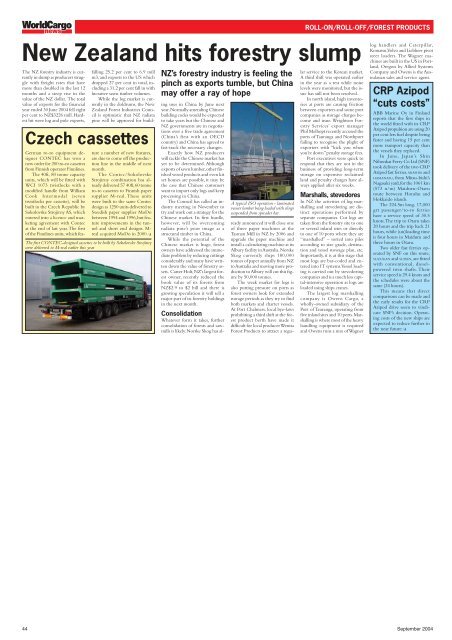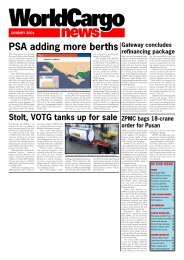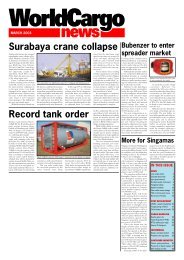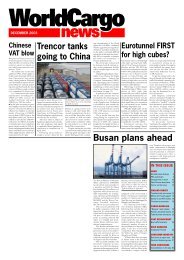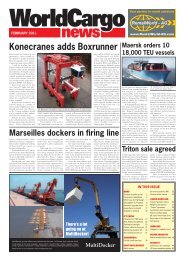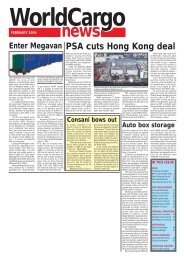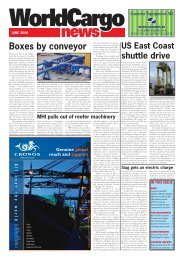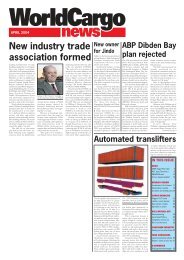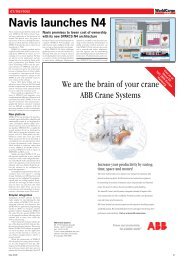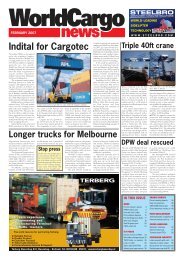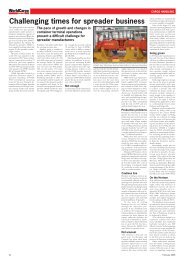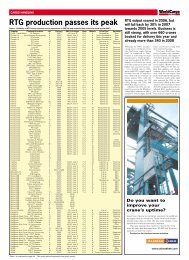WCN Sept Front page - WorldCargo News Online
WCN Sept Front page - WorldCargo News Online
WCN Sept Front page - WorldCargo News Online
Create successful ePaper yourself
Turn your PDF publications into a flip-book with our unique Google optimized e-Paper software.
<strong>WorldCargo</strong><br />
news<br />
New Zealand hits forestry slump<br />
The NZ forestry industry is currently<br />
in slump as producers struggle<br />
with freight rates that have<br />
more than doubled in the last 12<br />
months and a steep rise in the<br />
value of the NZ dollar. The total<br />
value of exports for the financial<br />
year ended 30 June 2004 fell eight<br />
per cent to NZ$3226 mill. Hardest<br />
hit were log and pole exports,<br />
Czech cassettes<br />
German ro-ro equipment designer<br />
CONTEC has won a<br />
new order for 200 ro-ro cassettes<br />
from Finnish operator Finnlines.<br />
The 40ft, 80 tonne capacity<br />
units, which will be fitted with<br />
WCI 1073 twistlocks with a<br />
modified handle from William<br />
Cook Intermodal (seven<br />
twistlocks per cassette), will be<br />
built in the Czech Republic by<br />
Sokolovske Strojirny AS, which<br />
entered into a licence and marketing<br />
agreement with Contec<br />
at the end of last year. The first<br />
of the Finnlines units, which fea-<br />
ture a number of new features,<br />
are due to come off the production<br />
line in the middle of next<br />
month.<br />
The Contec/Sokolovske<br />
Strojirny combination has already<br />
delivered 57 40ft, 60 tonne<br />
ro-ro cassettes to Finnish paper<br />
supplier M-real. These units<br />
were built to the same Contec<br />
design as 1250 units delivered to<br />
Swedish paper supplier MoDo<br />
between 1994 and 1996, but feature<br />
improvements in the tunnel<br />
and short end designs. M-<br />
real acquired MoDo in 2000. ❏<br />
The first CONTEC-designed cassettes to be built by Sokolovske Strojirny<br />
were delivered to M-real earlier this year<br />
NZ’s forestry industry is feeling the<br />
pinch as exports tumble, but China<br />
may offer a ray of hope<br />
falling 25.2 per cent to 6.9 mill<br />
m3, and exports to the US which<br />
dropped 27 per cent in total, including<br />
a 31.2 per cent fall in with<br />
lucrative sawn timber volumes.<br />
While the log market is currently<br />
in the doldrums, the New<br />
Zealand Forest Industries Council<br />
is optimistic that NZ radiata<br />
pine will be approved for building<br />
uses in China by June next<br />
year. Normally amending Chinese<br />
building codes would be expected<br />
to take years but the Chinese and<br />
NZ governments are in negotiations<br />
over a free trade agreement<br />
(China’s first with an OECD<br />
country) and China has agreed to<br />
fast-track the necessary changes.<br />
Exactly how NZ producers<br />
will tackle the Chinese market has<br />
yet to be determined. Although<br />
exports of sawn lumber, other finished<br />
wood products and even kit<br />
set houses are possible, it may be<br />
the case that Chinese customers<br />
want to import only logs and keep<br />
processing in China.<br />
The Council has called an industry<br />
meeting in November to<br />
try and work out a strategy for the<br />
Chinese market. Its first hurdle,<br />
however, will be overcoming<br />
radiata pine’s poor image as a<br />
structural timber in China.<br />
While the potential of the<br />
Chinese market is huge, forest<br />
owners have addressed the immediate<br />
problem by reducing cuttings<br />
considerably and many have written<br />
down the value of forestry assets.<br />
Carter Holt, NZ’s largest forest<br />
owner, recently reduced the<br />
book value of its forests from<br />
NZ$2.9 to $2 bill and there is<br />
growing speculation it will sell a<br />
major part of its forestry holdings<br />
in the next month.<br />
Consolidation<br />
Whatever form it takes, further<br />
consolidation of forests and sawmills<br />
is likely. Norske Skog has al-<br />
A typical ISO operation - laminated<br />
veneer lumber being loaded with slings<br />
suspended from spreader bar<br />
ROLL-ON/ROLL-OFF/FOREST PRODUCTS<br />
ready announced it will close one<br />
of three paper machines at the<br />
Tasman Mill in NZ by 2006 and<br />
upgrade the paper machine and<br />
install a calendaring machine at its<br />
Albury facility in Australia. Norske<br />
Skog currently ships 180,000<br />
tonnes of paper annually from NZ<br />
to Australia and moving more production<br />
to Albury will cut this figure<br />
by 50,000 tonnes.<br />
The weak market for logs is<br />
also putting pressure on ports as<br />
forest owners look for extended<br />
storage periods as they try to find<br />
both markets and charter vessels.<br />
At Port Chalmers, local bye-laws<br />
prohibiting a third shift at the forest<br />
product berth have made it<br />
difficult for local producer Wenita<br />
Forest Products to attract a regular<br />
service to the Korean market.<br />
A third shift was operated earlier<br />
in the year as a test while noise<br />
levels were monitored, but the issue<br />
has still not been resolved.<br />
In north island, high inventories<br />
at ports are causing friction<br />
between exporters and some port<br />
companies as storage charges become<br />
and issue. Wrightson Forestry<br />
Services’ export manager<br />
Phil Melhopt recently accused the<br />
ports of Tauranga and Northport<br />
failing to recognise the plight of<br />
exporters with “kick you when<br />
you’re down” penalty storage fees.<br />
Port executives were quick to<br />
respond that they are not in the<br />
business of providing long-term<br />
storage on expensive reclaimed<br />
land and penalty charges have always<br />
applied after six weeks.<br />
Marshalls, stevedores<br />
In NZ the activities of log marshalling<br />
and stevedoring are distinct<br />
operations performed by<br />
separate companies. Cut logs are<br />
taken from the forestry site to one<br />
or several inland sites or directly<br />
to one of 10 ports where they are<br />
“marshalled” – sorted into piles<br />
according to size grade, destination<br />
and vessel stowage plan, etc.<br />
Importantly, it is at this stage that<br />
most logs are bar-coded and entered<br />
into IT systems. Vessel loading<br />
is carried out by stevedoring<br />
companies and is a much less capital-intensive<br />
operation as logs are<br />
loaded using ships cranes.<br />
The largest log marshalling<br />
company is Owens Cargo, a<br />
wholly-owned subsidiary of the<br />
Port of Tauranga, operating from<br />
five inland sites and 10 ports. Marshalling<br />
is where most of the heavy<br />
handling equipment is required<br />
and Owens runs a mix of Wagner<br />
log handlers and Caterpillar,<br />
Komatsu, Volvo and Liebherr pivot<br />
steer loaders. The Wagner machines<br />
are built in the US in Portland,<br />
Oregon by Allied Systems<br />
Company and Owens is the Australasian<br />
sales and service agent.<br />
CRP Azipod<br />
“cuts costs”<br />
ABB Marine Oy in Finland<br />
reports that the first ships in<br />
the world fitted with its CRP<br />
Azipod propulsion are using 20<br />
per cent less fuel despite being<br />
faster and having 15 per cent<br />
more transport capacity than<br />
the vessels they replaced.<br />
In June, Japan’s Shin<br />
Nihonkai Ferry Co Ltd (SNF)<br />
took delivery of the two CRP<br />
Azipod fast ferries, AKASHIA and<br />
HAMANASU, from Mitsu-bishi’s<br />
Nagasaki yard, for the 1061 km<br />
(573 n/m) Maiduru-Otaru<br />
route between Honshu and<br />
Hokkaido islands.<br />
The 224.5m long, 17,000<br />
grt passenger/ro-ro ferries<br />
have a service speed of 30.5<br />
knots. The trip to Otaru takes<br />
20 hours and the trip back 21<br />
hours, while (un)loading time<br />
is four hours in Maiduru and<br />
three hours in Otaru.<br />
Two older fast ferries operated<br />
by SNF on this route,<br />
SUZURAN and SUISEN, are fitted<br />
with conventional, dieselpowered<br />
twin shafts. Their<br />
service speed is 29.4 knots and<br />
the schedules were about the<br />
same (24 hours).<br />
This means that direct<br />
comparisons can be made and<br />
the early results for the CRP<br />
Azipod drive seem to vindicate<br />
SNF’s decision. Operating<br />
costs of the new ships are<br />
expected to reduce further in<br />
the near future. ❏<br />
44<br />
<strong>Sept</strong>ember 2004


